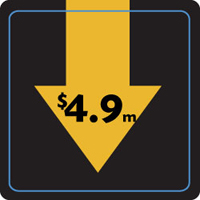Dalhousie is about to enter another budget season, and faculty, staff and students can expect plenty of discussion ahead about government grants, tuition fees and more.
The Budget Advisory Committee (BAC), which makes budget recommendations to the president, has just issued its first discussion report for 2013-14. This report outlines the budget scenario Dal faces in terms of revenue and expenditures, but doesn’t make concrete suggestions for balancing it (those come later).
While it’s not uncommon for the BAC report to identify a shortfall at this stage in the process, especially at a time when government operating grants are being reduced, the number is somewhat larger this year: $17.6 million that will have to be made up through spending cuts, efficiencies and increased revenue.
Read: The full Budget Advisory Committee discussion report [PDF]
Just where does that $17.6 million come from? We dug into the BAC report for an inside look at Dal’s budget, how it might be balanced, and how you can contribute to the process.
 Who is the Budget Advisory Committee?
Who is the Budget Advisory Committee?
The BAC issues two reports in advance of the budget itself each year: a discussion paper, followed by the budget proposal with recommendations for the fees and expenditures of a balanced budget. (That report comes out in February/March.)
The BAC is chaired by the university’s vice-president academic, Carolyn Watters, and includes three faculty members, an additional VP, one dean, a student representative, the vice-president administration and finance, the assistant vice-president of ancillary services and the director of budgets and financial planning.
Its budget discussions and reports (and all the analysis below) do not consider the Agricultural Campus budget, because for 2013-14 that budget is set in a separate agreement with the Province of Nova Scotia.
 The budget must be balanced
The budget must be balanced
This is a requirement of Dal’s Board of Governors. Any shortfall identified in the planning process has to be addressed, and there are three ways to do that: raise fees, recruit more students or make spending cuts.
Last year’s budget was balanced with revenues and expenditures at $330.9 million by implementing a 2.75% budget reduction across the university.
 Government funding: A $4.9 million cut
Government funding: A $4.9 million cut
More than half of Dal’s budget (54.3%) comes from an operating grant from the Province of Nova Scotia. But this support has been cut back significantly in recent years: a combined 10% since 2011-12 (an accumulation of $16.6 million less for Dal). This year, Dal will receive $4.9 million less from the government — a cut of 3%.
 Tuition: 3% fee increase = $3.7 million in revenue
Tuition: 3% fee increase = $3.7 million in revenue
That 3% number isn’t arbitrary: it’s the maximum that the province will let universities raise tuition this year in most programs. If Dal were to implement such an increase across the university, the $3.7 million raised would still not be enough to cover the funding cut from the province.
 Enrolment growth: can it help?
Enrolment growth: can it help?
More students equals more tuition equals more revenue. In recent years, Dal’s enrolment growth has helped cushion the university from more serious spending cuts.
Given the increased competition for students nationally and a decrease in regional high school students, the BAC is, for now, assuming flat enrolment for 2013-14 (though that may change as applications for Fall 2013 rise or fall). While Dal recruited a large class of international students this year, leading to slightly higher than expected enrolment revenue, new students from Canadian high schools declined for the second year in a row. Demographics suggest greater challenges ahead as the high school age population across the country continues to decline.
Even with the best efforts of Dal’s recruitment team, relying on enrolment to address ongoing budget shortfalls is an unlikely proposition.
 Increasing expenditures: salaries, pension investments, facilities and more
Increasing expenditures: salaries, pension investments, facilities and more
Having less money is only half of the budgeting challenge. The other half: many budget items continue to cost more.
Here are a few areas where Dal is expecting to spend more in 2013-14, and why:
1. Salaries: The largest expenditure in the budget, about 75% of Dal’s funds go to support faculty and staff. This expense goes up each year as regular salary adjustments occur across all of Dal’s employee groups, and with new collective agreements in place, the salary cost will increase by $9.7 million next year.
2. Pension contributions: The university must make up any shortfall in employee/employer contributions. An actuarial valuation of the pension fund is due in March, and preliminary estimates are that the university will need to add an additional $4 million to meet its “going concern” requirements.
3. Energy, water, taxes and insurance: Just as you keep paying more for these services, so does Dal – an estimated $686,000 (4.5%) more next year.
4. Operating costs of new buildings: Dal’s two new buildings set to open next year – the Oceans Science Research Building and the LeMarchant Street Mixed-Use Building — will add an estimated $1.28 million to the budget for maintenance and upkeep.
5. Facilities renewal: To help address necessary maintenance and upkeep to its more than 100 buildings, Dal has been increasing its facilities renewal budget by $1 million each year as recommended by the Board’s Long Term Financial Planning Committee.
 The challenge: finding $17.5 million
The challenge: finding $17.5 million
When you take Dal’s expected revenues — assuming a 3% tuition increase — and place them up against planned expenditures, you end up with a $17.6 million gap that the university will have to close before the budget is passed.
So just where do you find $17.6 million in the Dal budget? The BAC report outlines a few of the options the committee is considering:
1. Larger fee increases for some students: The government does allow an increase of more than 3% in a few areas where it typically costs more to deliver competitive programs and services: medicine, law, dentistry and the differential fee for international students. A 1% increase in one of the professional programs generates approximately $125,000 in revenue, while the same percentage increase to the international differential brings in $120,000. But all of these groups have faced larger fee hikes in recent years than the rest of the university, so further increases have to be carefully considered.
2. Budget cuts: Dal’s taken a number of different approaches to budget reductions over the past 10 years, sometimes making slightly larger cuts to Faculties (which can increase revenues if they attract more students) than to service units (which can’t). If Dal were to try and address its budget deficit only through spending cuts, and applied them as it has in previous years, all units would be asked to cut 7.5% of their budgets. (For comparison: this past year’s cut was 2.75%.)
3. Tap into reserve funds: Dal has an accumulated surplus fund from previous years when enrolment turned out better than expected. This $5.9 million is available to address a budget shortfall, but only on a one-time basis. Dal must be careful in using one-time funds for long-term issues, as it may only defer tough choices until the next budget.
4. Make changes to strategic initiatives funding: Each year Dal puts aside funding to address key strategic priorities to stay competitive with its peers. In recent years, the university has spent most of this on one-time projects to avoid adding to the regular operating budget. Currently the BAC report assumes the same amount of funding will be available for these projects ($3.38 million) on a one-time basis, but this is also up for discussion.
5. Facilities renewal: Dal could reduce or forgo the $1 million increase this year.
You may be wondering what role Dal’s $250 million capital campaign plays in this discussion. Bold Ambitions donations are targeted as designated by donors to go towards specific projects and initiatives in key areas like student success, student experience, sustainability, design and innovation and more. These do help the operating budget, in so much as they reduce the amount of operating funds needed to make these projects possible. But the operating budget itself can’t rely on donations; its goal is to keep Dal’s funding model as reliable and consistent as possible.
 Next steps – a chance to provide your feedback
Next steps – a chance to provide your feedback
Ultimately, it will take a combination of approaches to balance the budget — perhaps including measures that have yet to be considered. The committee is looking for your feedback on how best to approach the budget this year. Some of the questions its members are asking:
• How should Dal approach making cuts to Faculty and service unit budgets?
• Should additional fee increases be applied to Medicine, Law, Dentistry and International Students?
• Should Dal take advantage of its one-time reserve fund?
• How should the university consider strategic initiative funding?
• Should Dal forego its increase in facilities renewal spending?
BAC members will be meeting with key groups across campus in the weeks ahead to consider these and other questions. If you’d like to submit feedback on the report in writing, you can do so by emailing Susan Robertson in Financial Services at susan.robertson@dal.ca.
In late February or early March, the BAC’s second report will be issued, which will include recommendations for tuition and fees and a proposed solution for next year's budget. Students can then expect a series of forums across campus in March — a chance to offer feedback on tuition and fees as part of the Board-approved fee consultation process.
Editor's note: The originally published version of this story used "$17.5 million" as the number for the identified budget shortfall. As the actual number is $17.55 million, we have rounded up to $17.6 million for consistency with other published budget documents.

